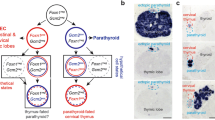Abstract
Mechanism of thymic compartmentalization was studied in the transgenic system using the promoter of thymic stromal cotransporter (TSCOT), a cortical thymic epithelium-specific gene. The transgenic 3.1 kb TSCOT (3.1T) and 4.4 kb TSCOT (4.4T) promoters recapitulated the thymic organ and the cortical epithelial cell-specific expression at the newborn stage. However, the 3.1T driving enhanced green fluorescent protein (EGFP; 3.1T-EGFP) or Cre-recombinase (3.1T-CreE) redistributed the expression into the medulla at the adult stages. Two Cre-transgenic lines (3.1T-CreE and 4.4T-CreE), when crossed with the ROSA LacZ or EGFP lines, showed the reporter expression in both the cortex and the medulla. TSCOT promoter activities were also verified in the transient thymic epithelial cell (TEC) population expressing keratin 5 and keratin 8. These indicate that the TSCOT promoter is turned on in the bipotent TEC precursors and regulated in a compartment-specific, developmentally regulated fashion. These transgenic lines provide the useful systems for delineating the specific pathways for TEC lineage development and function.
This is a preview of subscription content, access via your institution
Access options
Subscribe to this journal
Receive 6 digital issues and online access to articles
$119.00 per year
only $19.83 per issue
Buy this article
- Purchase on Springer Link
- Instant access to full article PDF
Prices may be subject to local taxes which are calculated during checkout




Similar content being viewed by others
References
Anderson G, Jenkinson EJ, Rodewald HR . A roadmap for thymic epithelial cell development. Eur J Immunol 2009; 39: 1694–1699.
Manley NR . Thymus organogenesis and molecular mechanisms of thymic epithelial cell differentiation. Semin Immunol 2000; 12: 421–428.
Boehm T, Scheu S, Pfeffer K, Bleul CC . Thymic medullary epithelial cell differentiation, thymocyte emigration, and the control of autoimmunity require lympho-epithelial cross talk via LTbetaR. J Exp Med 2003; 198: 757–769.
Petrie HT, Kincade PW . Many roads, one destination for T cell progenitors. J Exp Med 2005; 202: 11–13.
Anderson G, Takahama Y . Thymic epithelial cells: working class heroes for T cell development and repertoire selection. Trends Immunol 2012; 33: 256–263.
Blackburn CC, Manley NR, Palmer DB, Boyd RL, Anderson G, Ritter MA . One for all and all for one: thymic epithelial stem cells and regeneration. Trends Immunol 2002; 23: 391–395.
Nitta T, Ohigashi I, Nakagawa Y, Takahama Y . Cytokine crosstalk for thymic medulla formation. Curr Opin Immunol 2011; 23: 190–197.
Gill J, Malin M, Hollander GA, Boyd R . Generation of a complete thymic microenvironment by MTS24(+) thymic epithelial cells. Nat Immunol 2002; 3: 635–642.
Blackburn CC, Manley NR . Developing a new paradigm for thymus organogenesis. Nat Rev Immunol 2004; 4: 278–289.
Baik S, Jenkinson EJ, Lane PJ, Anderson G, Jenkinson WE . Generation of both cortical and Aire(+) medullary thymic epithelial compartments from CD205(+) progenitors. Eur J Immunol 2013; 43: 589–594.
Yang SJ, Ahn S, Park CS, Holmes KL, Westrup J, Chang CH et al. The quantitative assessment of MHC II on thymic epithelium: implications in cortical thymocyte development. Int Immunol 2006; 18: 729–739.
Roberts NA, White AJ, Jenkinson WE, Turchinovich G, Nakamura K, Withers DR et al. Rank signaling links the development of invariant gammadelta T cell progenitors and Aire(+) medullary epithelium. Immunity 2012; 36: 427–437.
Rodewald HR, Paul S, Haller C, Bluethmann H, Blum C . Thymus medulla consisting of epithelial islets each derived from a single progenitor. Nature 2001; 414: 763–768.
Klug DB, Carter C, Gimenez-Conti IB, Richie ER . Cutting edge: thymocyte-independent and thymocyte-dependent phases of epithelial patterning in the fetal thymus. J Immunol 2002; 169: 2842–2845.
Klug DB, Crouch E, Carter C, Coghlan L, Conti CJ, Richie ER . Transgenic expression of cyclin D1 in thymic epithelial precursors promotes epithelial and T cell development. J Immunol 2000; 164: 1881–1888.
Kim MG, Chen C, Flomerfelt FA, Germain RN, Schwartz RH . A subtractive PCR-based cDNA library made from fetal thymic stromal cells. J Immunol Methods 1998; 213: 169–182.
Kim MG, Flomerfelt FA, Lee KN, Chen C, Schwartz RH . A putative 12 transmembrane domain cotransporter expressed in thymic cortical epithelial cells. J Immunol 2000; 164: 3185–3192.
Yang SJ, Ahn S, Park CS, Choi S, Kim MG . Identifying subpopulations of thymic epithelial cells by flow cytometry using a new specific thymic epithelial marker, Ly110. J Immunol Methods 2005; 297: 265–270.
Ahn S, Lee G, Yang SJ, Lee D, Lee S, Shin HS et al. TSCOT+ thymic epithelial cell-mediated sensitive CD4 tolerance by direct presentation. PLoS Biol 2008; 6: e191.
Lee GH, Kim Ki Yeon, Chang Cheong-Hee, Kim Moon Gyo . Specific thymic epithelial requirement for gamma delta T cell development revealed in the cell ablation transgenic system with TSCOT promoter. Mol Cells 2012; 35: 5.
Chen C, Kim MG, Soo Lyu M, Kozak CA, Schwartz RH, Flomerfelt FA . Characterization of the mouse gene, human promoter and human cDNA of TSCOT reveals strong interspecies homology. Biochim Biophys Acta 2000; 1493: 159–169.
Acknowledgements
We thank Dr Ronald H Schwartz for the generous support in the generation and maintenance of the mouse lines and Dr Hanwoong Lee for the help in maintaining the mouse lines. We also thank Seung Hyuk Lee and Dong Young Kim for their technical help.
This work was supported by the Korean Health Technology R+D project, Ministry of Health and Wellness (A110703) and Inha University Research Grant.
Author information
Authors and Affiliations
Corresponding author
Ethics declarations
Competing interests
The authors declare no conflict of interest.
Additional information
Supplementary Information accompanies this paper on Genes and Immunity website
Rights and permissions
About this article
Cite this article
Park, CS., Lee, G., Yang, S. et al. Differential lineage specification of thymic epithelial cells from bipotent precursors revealed by TSCOT promoter activities. Genes Immun 14, 401–406 (2013). https://doi.org/10.1038/gene.2013.30
Received:
Revised:
Accepted:
Published:
Issue Date:
DOI: https://doi.org/10.1038/gene.2013.30
Keywords
This article is cited by
-
Thymus involution and regeneration: two sides of the same coin?
Nature Reviews Immunology (2013)



